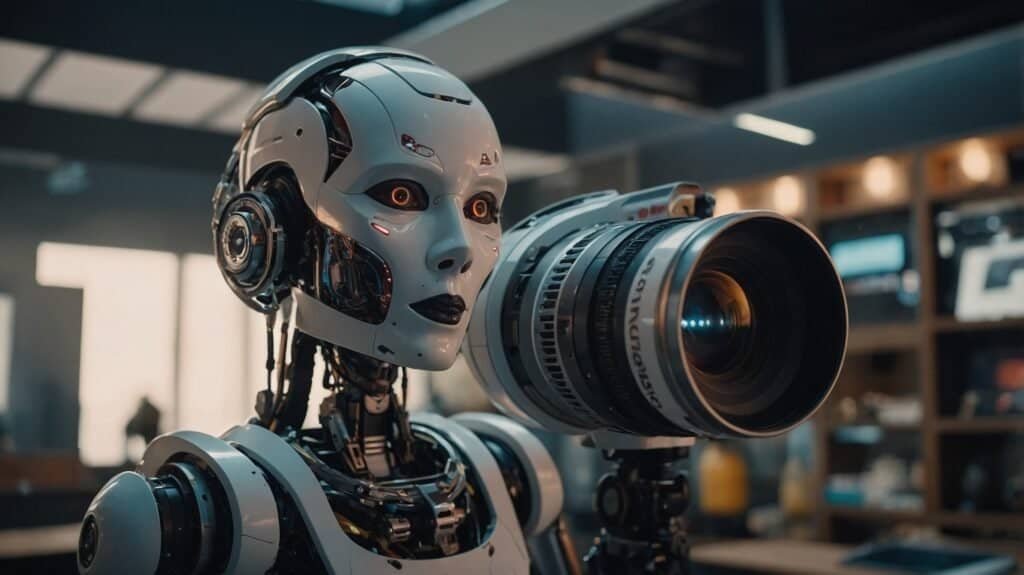In this comprehensive blog, we will explore these questions and more, delving into the professional-level intricacies of AI-driven content creation and its implications for the future of digital media.
The Evolution of AI in Content Creation
A Brief History of AI in Media and Content
AI’s roots in content creation can be traced back to early algorithms that powered basic grammar and spell-checking tools. Over time, these algorithms evolved into more sophisticated systems capable of generating human-like text, analyzing vast datasets, and even predicting content trends. Today, AI is embedded in various aspects of content creation, from writing and editing to visual and audio production.
The journey from rudimentary automation to advanced AI-driven content generation has been marked by significant milestones. Tools like Grammarly, which initially served as basic proofreading aids, now leverage AI to offer nuanced writing suggestions that go beyond simple grammar correction. Similarly, platforms like BuzzFeed and The Washington Post have experimented with AI-generated news articles, proving that AI can be a valuable tool in journalistic endeavors.
The Current State of AI in Content Creation
Today, AI is not just an auxiliary tool but a central player in content creation. AI-driven platforms like OpenAI’s GPT-3, Jasper (formerly Jarvis), and Copy.ai are capable of generating entire articles, marketing copy, and even creative stories with minimal human intervention. These tools use machine learning models trained on vast amounts of text data, enabling them to produce content that closely mimics human writing.
In addition to text generation, AI is also transforming other content formats. For instance, AI-powered video editing tools like Wondershare and Lumen5 can automatically create video content from scripts or raw footage, while AI-driven design platforms like Canva use machine learning to suggest design elements that align with the user’s style and brand.

How AI Works in Content Creation
Understanding Natural Language Processing
At the core of AI-driven content creation is Natural Language Processing (NLP), a subfield of AI that focuses on the interaction between computers and human language. NLP enables machines to understand, interpret, and generate text that is contextually relevant and grammatically correct. This technology powers a wide range of applications, from chatbots and virtual assistants to AI-generated articles and social media posts.
NLP works by analyzing the structure and meaning of text through various techniques such as tokenization, sentiment analysis, and machine translation. For example, when generating content, an AI model might use tokenization to break down sentences into individual words or phrases, which are then analyzed for context and meaning. The AI can then generate new content based on this analysis, ensuring that the output is coherent and contextually appropriate.
Machine Learning and Deep Learning in Content Creation
Machine learning (ML) and deep learning (DL) are the driving forces behind AI’s ability to generate high-quality content. These technologies involve training models on large datasets, enabling them to recognize patterns and make predictions. In the context of content creation, ML and DL models are trained on vast corpora of text, images, and videos, allowing them to generate new content that closely resembles the input data.
For instance, OpenAI’s GPT-3 is a deep learning model trained on hundreds of billions of words, enabling it to generate text that is often indistinguishable from human writing. Similarly, AI tools like DALL-E use deep learning to create images from textual descriptions, opening new possibilities for visual content creation.
AI in Visual and Audio Content Creation
AI is not limited to text; it is also making significant strides in visual and audio content creation. AI-powered tools like Adobe Sensei and Runway ML can generate and edit images, videos, and even audio tracks. These tools use machine learning algorithms to analyze existing media and produce new content that aligns with the user’s specifications.
For example, Adobe Sensei can automatically suggest edits to images based on the content and style, while Runway ML allows users to generate realistic 3D models and animations with minimal effort. In the audio space, AI tools like AIVA and Amper Music can compose original music tracks, making it easier for content creators to add high-quality audio to their projects.

Why AI in Content Creation Matters
Efficiency and Scalability
One of the most significant advantages of AI in content creation is its ability to streamline workflows and scale production. Traditional content creation processes can be time-consuming and labor-intensive, often requiring multiple rounds of drafting, editing, and approval. AI can significantly reduce these timelines by automating many of these tasks, allowing content creators to focus on strategy and creativity. Moreover, by integrating AI tools into their workflow, content creators can produce higher volumes of work without sacrificing quality. This efficiency not only enhances productivity but also lays the groundwork for a longterm ai content strategy that aligns with evolving audience preferences and market trends. Consequently, organizations can adapt more swiftly to changes, ensuring their content remains relevant and impactful. Additionally, ai tools for content creation enable creators to generate personalized content at scale, catering to diverse audiences without sacrificing quality. By leveraging these tools, teams can experiment with different formats and styles, ensuring that their output remains fresh and engaging. As a result, the overall effectiveness of content marketing strategies can be significantly enhanced, leading to better audience engagement and conversion rates. Additionally, AI tools can analyze audience preferences and trends, providing valuable insights that inform content strategy. By tailoring content to specific demographics, creators can enhance engagement and reach. However, to fully realize these benefits, it is essential to address the challenges in the field, particularly in overcoming AI content creation hurdles that may arise from biases in data or lack of human touch in storytelling.
For instance, an AI-powered content generator can produce a first draft of an article in minutes, freeing up writers to spend more time on refinement and ideation. Similarly, AI-driven video editing tools can automatically create clips from raw footage, reducing the need for manual editing and enabling faster turnaround times.
Enhanced Creativity and Innovation
While some may argue that AI stifles creativity, the opposite is often true. By automating routine tasks, AI allows content creators to focus on more innovative aspects of their work. Additionally, AI can serve as a source of inspiration, generating new ideas and perspectives that human creators might not have considered.
For example, AI tools can generate hundreds of variations of a marketing slogan, giving copywriters more options to choose from and iterate upon. Similarly, AI-driven design platforms can suggest unique color schemes and layouts, helping designers explore new aesthetic possibilities.
Data-Driven Content Strategies
AI’s ability to analyze vast amounts of data in real-time enables more informed content strategies. Tools like SEMrush use AI to analyze audience behavior, track content performance, and predict trends, allowing marketers to create content that is more likely to resonate with their target audience.
For instance, AI can identify which types of content are most popular among a specific demographic, enabling marketers to tailor their campaigns accordingly. This data-driven approach not only improves the effectiveness of content but also maximizes return on investment.

Quality Control and Human Oversight
While AI can produce content quickly and efficiently, it’s not infallible. AI-generated content can sometimes lack the nuance and creativity that human creators bring to the table. Additionally, AI models are only as good as the data they are trained on, meaning that biases in the training data can lead to biased content.
To mitigate these risks, human oversight is essential. Content creators should use AI as a tool to enhance their work, not replace it entirely. Regularly reviewing and editing AI-generated content can help ensure that it meets quality standards and aligns with the intended message.
The Future of AI in Content Creation
AI and the Evolution of Content Formats
As AI continues to evolve, it will likely drive the development of new content formats and experiences. For example, AI-powered interactive content, such as personalized videos or dynamic web pages, could become more prevalent, offering users a more engaging and tailored experience.
In the gaming industry, AI is already being used to create adaptive narratives that change based on player decisions. This concept could easily extend to other forms of content, such as interactive books or personalized marketing campaigns.

